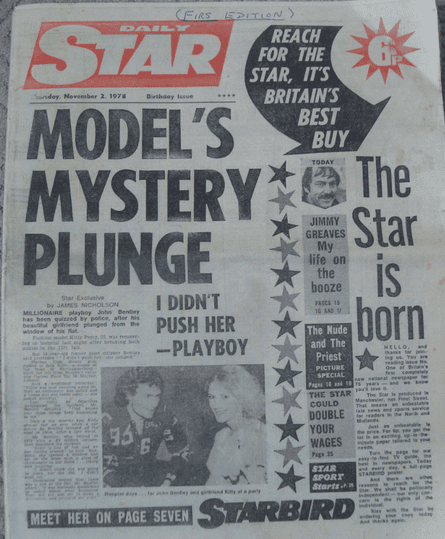Posters went up across Manchester in October 1978 proclaiming the arrival of a new daily newspaper: “A Star is born”. On his way into the office, the paper’s editor-in-chief, Derek Jameson, was upset to see that one had been defaced. His taxi driver, after laughing at the amendment, “A Star is porn”, told him: “You shouldn’t worry – it will double circulation.” Little did either man know that the paper would eventually fall into the hands of two pornographers.
On Friday, the Daily Star celebrates its 40th anniversary, although it’s hardly worth marking. It has become a pathetic article, a travesty of a newspaper, having lost any sense of purpose. Yet it obviously fills some need, because it sells 355,000 copies a day, and its print decline is no worse than that of its rivals.
It survives on a diet of sex, still featuring a topless model on Page 3 each day, and on celebrity trivia. The Star is a newspaper without either news or views. If it can be said to have any political outlook at all, then it is rightwing. There is no passion, no commitment, no soul.
Given its strange birth, it is no surprise it has grown into middle-aged nonentity. Some people launch newspapers as a public service; some do so because they want to change the world; some just want to make money. But Victor Matthews, the then proprietor of Express Newspapers, and his managing director, the buffoonish Jocelyn Stevens, decided to launch the Daily Star simply to solve an internal company problem.
Their printing presses were underused due to falling Daily Express circulation but, in the face of intransigent print union militancy, there was no question of reducing staff. Instead, to take up the slack, Stevens told union leaders they would be expected to publish a new tabloid and cannily informed them it would “a paper of your own”, a tacit hint that the Star would be pro-Labour.
At the time, another red-top looked anything but a good idea because there was no obvious gap in the market. The Sun was in the ascendancy, selling just short of 4m a day, and the Daily Mirror, although sliding down the sales ladder, still had 3.8m. Surely, there was no audience for the Daily Star?
Matthews and Stevens, though they never acknowledged it, were fortunate in their choice of editor: Peter Grimsditch, ex-Daily Mail, Sunday Mirror and deputy editor of Reveille. As Jameson later remarked, Grimsditch’s “manic energy” was at the heart of the project. “Eyes ablaze with missionary zeal”, he convinced “a handful of true believers” that it was possible to create a saleable paper that would, in its initial stages, be distributed only in England’s northern and Midlands regions.

One advantage would be sport. The Sun, then printed only in London, could not get overnight match reports and results to readers in the football-mad northern cities. Moreover, the Sun’s editor, Larry Lamb, had lost his way, devoting too many front pages to serious political issues and eschewing the wit that had marked his feted early period. Grimsditch and his small team of Fleet Street veterans, including the Sun’s former art director, Vic Giles, seized the chance to forge a paper that evoked memories of the Sun’s cheekier days. It was also informed by a markedly left-of-centre political line. So, against the odds, the entire 1.4m print run of the first issue of the Daily Star, on 2 November 1978, sold out. And it kept on selling.
Grimsditch’s first disappointment came before the following year’s general election. Matthews would not hear of the Star backing Labour, though he overlooked the fact that the Star offered no support to Margaret Thatcher. Then, after a bit of Jameson chicanery, Grimsditch was fired. He was not around to enjoy the extra sales gained when the paper launched a bingo game and was distributed nationally.
By early 1981, the Star was living up to Grimsditch’s dream by regularly achieving sales of more than 1.5m while the Sun, to the consternation of its owner, Rupert Murdoch, went into reverse. As one wit remarked, it was the first time a Star had eclipsed the Sun. Murdoch took swift action: he fired Lamb and replaced him with Kelvin MacKenzie. I was the Star’s features editor at the time, and there was a misconception that I had played a key role in the paper’s success. On that basis, I became MacKenzie’s assistant editor.
For the following seven years or so, the Sun could never afford to ignore the Star. Its editor, Lloyd Turner, a former Daily Express night editor, proved to be a formidable opponent. He built on the Grimsditch formula, improving the news and features coverage, and by maintaining a non-Tory viewpoint, he managed to steal readers from the Mirror.
Turner’s downfall in 1987 was dramatic and proved to be the turning point in the Star’s fortunes. He followed up a News of the World revelation about the relationship between the then Conservative party deputy chairman, Jeffrey Archer, and a prostitute. The Star went much further than the original story by stating that Archer had had sex with the woman. Archer sued for libel, outrageously won the case and was awarded £500,000 damages.
Turner was duly fired and, according to his wife, he “was left a broken man, with his reputation in tatters”. He died five years before he was vindicated. In 2001, Archer was exposed as a liar and sentenced to jail for four years after being convicted of perjury and perverting the course of justice.
After Turner’s departure, the Star’s new proprietor, Lord Stevens, astonished rival press owners by handing control of the paper to David Sullivan, the owner of sex shops, publisher of pornographic magazines and founder of a paper infamous for its fabricated stories and headlines, the Sunday Sport. Sullivan appointed Mike Gabbert as the Star’s editor and he transformed the paper overnight after pledging to publish “the biggest boobs possible” in every issue.
He dared to run semi-naked pictures of a 15-year-old girl who vowed to go topless when she turned 16. The exploitative nature of the exercise resulted in staff resignations. Circulation plummeted instantly. MPs denounced the paper in parliament. Advertisers, including Tesco, cancelled their contracts. After eight weeks, Stevens pulled out of the deal, but the damage was done.
The Star went into freefall despite the efforts of its next editor, the fervently rightwing Brian Hitchen. By 1998 sales had fallen to 540,000. It is a tribute to the professionalism of Peter Hill, who took the helm in that year, that he reversed the downward trend by switching the editorial agenda. In a counterintuitive move, he ignored main news events and splashed instead on offbeat stories. It worked and sales were rising in 2000 when Express Newspapers was acquired by the “adult magazine” entrepreneur Richard Desmond. Once more, the Star found itself in the hands of a pornographer.
Hill convinced Desmond to double the photographic budget before what proved to be the Star’s emergence as an unashamed celebrity sheet, an editorial approach enthusiastically taken up by the next editor, Dawn Neesom. She departed in February this year after Reach (the Daily Mirror’s owner) bought the Express titles. Since then, it has concentrated on purveying vacuous gossip about the “stars” of reality TV shows. The dream of a credible, leftwing Sun had died long ago. Now, there is no point to its existence.

